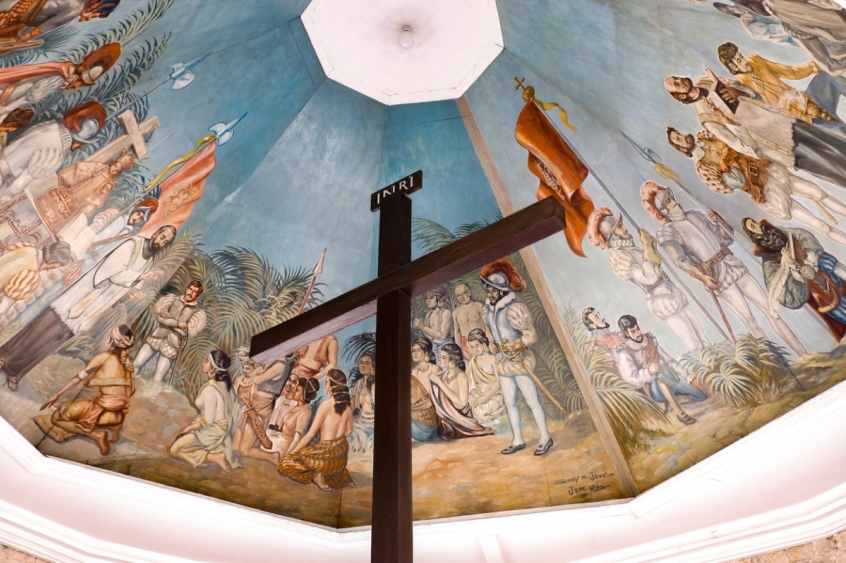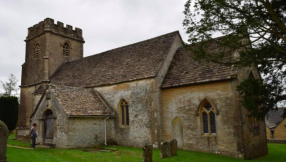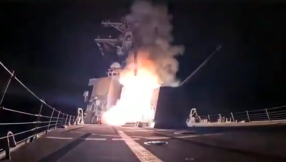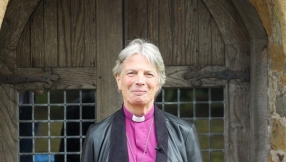
The writer of the Letter to the Hebrews reminds Christians that they are surrounded by a great "cloud of witnesses." (NRSV) That "cloud" has continued to grow in size since then. In this monthly column we will be thinking about some of the people and events, over the past 2000 years, that have helped make up this "cloud." People and events that have helped build the community of the Christian church as it exists today.
Today, most Filipinos identify as Christian (92.5%). More specifically, 82.9% identify as Catholic, 2.8% identify as Evangelical Christian, 2.3% identify as Iglesia ni Kristo (an indigenous church popular among the marginalised in society, who feel disconnected from the Catholic Church) and 4.5% identify with some other Christian denomination.
The Catholic Church and state were officially separated in the 1990s. Despite this, Catholic Christianity still plays a prominent role in politics and society. The roots of this go back to when the Philippines were a Spanish colony.
A complex relationship between Filipino Christians and colonial rulers (first the Spanish and then the Americans) led to two extraordinary revolutionary uprisings by Catholic Filipinos who felt marginalised by their colonial co-religionists.
The Cofradía de San José, 1832–41
The Cofradía de San José first appeared in 1832 in the province of Tayabas (now Quezon), and its activities soon spread to the adjacent provinces of Laguna and Batangas and broke out into a full uprising in 1841.
The movement was prompted by the refusal of Catholic religious orders to admit native Filipinos (indios) as members. In response, a devout Catholic of peasant stock, named Apolinario de la Cruz decided to form a religious order which would only admit native people.
He called the order the Cofradía de San José (Confraternity of St. Joseph) and at its height it had somewhere in the region of 4,500 to 5,000 members. Apolinario became known to his followers as Hermano Pule (Brother Pule). The movement banned Spanish colonists and mestizos (mixed-race locals) from joining, unless given specific permission by Pule.
The movement combined Roman Catholic beliefs and practices with some that were native pre-Christian. In this it drew on a mixed heritage that was distinctive to the Philippines. The Catholic conversion process there had occurred in a complex way, which saw some areas rapidly Christianised, while in other areas (particularly mountainous regions) the process was more spasmodic and lacked depth.
Attempts to have the movement recognized by the Catholic Church in the Philippines failed and, from 1840, the colonial authorities began to mobilize against the group. As well as accusing the group of heresy, there was a fear that the size of the movement might pose an armed threat to colonial government. In October 1840, 243 cofradía members were arrested. Further attempts to persuade ecclesiastical authorities that the group was not heretical failed.
The Spanish governor-general declared the movement subversive and ordered the arrest of its members. This forced Pule into hiding. Fearing further persecution, he rallied those members who had avoided capture and about 4,000 of them gathered on the slopes of Mount Banahaw. There they were joined by Aetas (a still-pagan indigenous people) living in the Sierra Madre mountains. They made common cause against the Spanish colonial authorities.
It was in this atmosphere of mounting threat of military intervention, that the apocalyptic nature of the movement emerged. Prior to this, some acceptance by colonial church authorities might have ensured that the group generally operated within official church boundaries; and would have prevented its development into an armed force.
Whether this could have occurred, given its mixed religious ideology and origins outside of official ecclesiastical structures, is perhaps unlikely. What is certain is that the racist exclusivity of the religious orders – and a refusal to dialogue with the group – accelerated its movement towards radicalization.
Official armed forces attacked the cofradía camp but were initially defeated. It was at this point that the cofradía crowned Pule as king. Pule and the other cofradía leaders promised that God would intervene to grant them victory; they would be protected from enemy bullets; angels would appear and assist them in battle; the ground would open and swallow the enemy soldiers.
However, in the ensuing battle the cofradía were heavily defeated, losing perhaps as many as 500 members, compared with government casualties that numbered just eleven wounded. A movement which had finally developed a millenarian character in response to colonial persecution, had collapsed in its final apocalyptic struggle.
Pule was eventually captured, tortured, and executed in 1841 and his quartered body-parts were put on public display by the Spanish colonial authorities. About 200 others who had joined in the resistance were also executed at the same time.
Members of the Cofradía de San José, who survived the crushing of the revolt, continued as a religious movement and became known as colorums. This was derived from the phrase "saecula saeculorum" (to the ages of ages), used to end prayers during the Catholic Mass. But revolutionary millenarian Catholic rebellion would break out again within a generation. This time, though, the target would be American imperialists.
The Santa Iglesia movement, 1900–10
A revolutionary society known as the Katipunan – which sought independence from Spain – began the Philippine Revolution in 1896 and independence from Spain was declared in 1898. The First Philippine Republic was established in 1899. However, Spain had ceded the islands to the US (along with Puerto Rico and Guam), following defeat in the Spanish-American War, in 1898. The Americans did not recognize the Philippine Republic and, in the resulting Philippine-American War, somewhere between 250,000 to one million civilians died as the US took control of the islands.
In 1900 Felipe Salvador founded the Santa Iglesia (Holy Church), after the defeat of Filipino forces by the Americans. He had earlier joined the Katipunan, who were fighting the Americans (having exchanged one colonial occupier – Spain – for another – the US). Sheltering in the mountains, he used these as a base for resisting US control.
The Santa Iglesia fused religious and nationalist ideology. Its underpinning beliefs were strongly anti-colonial and anti-official Catholicism. Salvador carried a large crucifix and took the title 'pontiff' (pope), grew his hair long, wore clothing reminiscent of biblical figures and was revered by his followers as a prophet. As he preached, twelve of his followers would face him; another twelve would face the assembled people.
As with many such movements experiencing severe cultural stress, it was accelerating into end-times extremism. Salvador prophesied the coming of a second "great flood" (as in the days of Noah) which would drown all non-believers. Other accounts refer to a prophecy of a "rain of fire." Following this, gold and jewels would rain down on his followers. As they prepared to fight the US military, he also promised that God would turn their knives into rifles. Once victory was achieved, land would be redistributed to the poor. The impoverished and the landless flocked to his apocalyptic cause.
The Santa Iglesia stood within a very particular revolutionary tradition in the Philippines which saw the war years as part of a great cataclysm that would signal the end of the world. As with the earlier Cofradía de San José it combined end-times Christian beliefs, and folk themes, with nationalist hostility towards the Spanish and then the Americans.
Salvador was captured in 1901 but escaped in 1902. He was now something of a folk hero to poor people. However, facing military defeats at the hands of the Americans and their allies, the movement began to collapse, and he went on the run. He was finally captured by US forces in 1910; sentenced to death; and hanged in 1912.
After his death, a cult focused on him – called Apo Ipe – emerged and was still in existence as late as the 1920s. After him, other millenarian leaders continued to gain followers by claiming they had eaten with him or talked with him. Belief in his semi-messianic status continued for a surprisingly long time after his death.
The two movements compared
The two groups did not begin as revolutionary end-times movements. Both started as spiritual initiatives, designed to meet the needs of believers who were being excluded from the ecclesiastic structures of colonial society. It was the persecuting responses of the colonial authorities which ratcheted up the crisis and created a situation within which radicalization would occur. The two movements became increasingly millenarian in direct proportion to the antagonism they faced from the colonial and church authorities. In short, repression triggered apocalyptic responses.
Curiously, the two movements were able to rapidly morph into apocalyptic-mode because there was a pre-existing form of marginalized and lower-class Catholic faith in the Philippines which had been primed by the restricting and racist attitudes prevalent among colonial authorities and the leadership of the Catholic Church.
This was vividly seen in the responses to the pre-existing Pasyón (Passion) tradition in the Philippines. The Pasyón was – and still is – a Philippine epic of the passion, death, and resurrection of Jesus Christ. The uninterrupted chanting of this is a popular Catholic devotion during Lent, and is particularly enacted during the week leading up to Easter. It was approved in 1704 for use in Catholic events. By the nineteenth century, and the emergence of the Cofradía de San José and the later Santa Iglesia, it was deeply ingrained in popular culture.
What the Church authorities did not recognise was its revolutionary potential. Celebrating the Pasyón intimately acquainted marginalized rural Filipinos with the New Testament belief in Christ's suffering, victory, and coming again in glory. Those who took part injected lower-class enthusiasm into these stories in ways that were not controlled by the Church hierarchy. Looked down on by many in the Church and state, many poor Filipinos began to believe that end-times expectations were realizable in the here and now, and such attitudes made people more likely to join in with the uprisings.
A common belief developed through the Pasyón was that Hesukristo (Jesus Christ) was particularly the saviour of the poor and downtrodden. As a result, the leaders of both movements likened themselves and their mission to the well-known image of Hesukristo. In so doing, their claims resonated with popular religious beliefs and gained the respect and support of many ordinary people.
Liberation from exploitation and oppression in the 'here and now' was linked to liberation in an eternal sense and the hope of end-times justification. As a result, both groups can be clearly differentiated from many modern anti-colonial movements, which take their frames of reference from secular political ideologies (eg Marxism or socialism).
In contrast, those who supported the Cofradía de San José and the Santa Iglesia framed their actions within the mindset of Christian (especially apocalyptic) beliefs and saw their liberation as depending on the direct intervention of God.
These remarkable revolutions occurred because many marginalized Filipinos confronted powerful and discriminatory authorities in Church and state with radical apocalyptic beliefs that they had been taught about but had never been expected to put into practice.
Martyn Whittock is an evangelical historian and a Licensed Lay Minister in the Church of England. As an historian and author, or co-author, of fifty-four books, his work covers a wide range of historical and theological themes. In addition, as a commentator and columnist, he has written for several print and online news platforms; has been interviewed on radio shows exploring the interaction of faith and politics; and appeared on Sky News discussing political events in the USA. Recently, he has been interviewed on several news platforms concerning the war in Ukraine. His most recent books include: Trump and the Puritans (2020), The Secret History of Soviet Russia's Police State (2020), Daughters of Eve (2021), Jesus the Unauthorized Biography (2021), The End Times, Again? (2021) and The Story of the Cross (2021). He has recently completed Apocalyptic Politics (2022 forthcoming), which explores the connection between end-times beliefs and radicalized politics across religions, time, and cultures.













